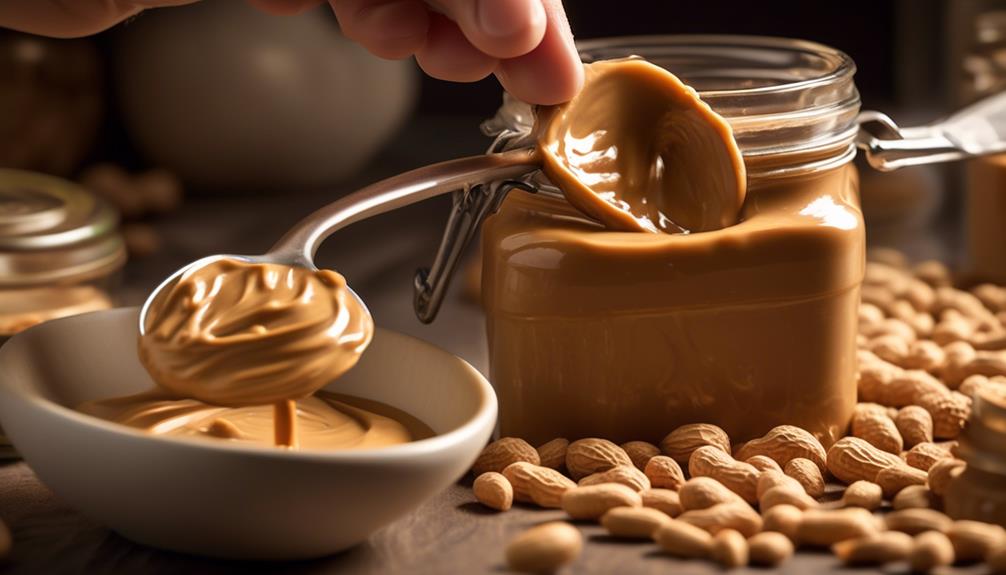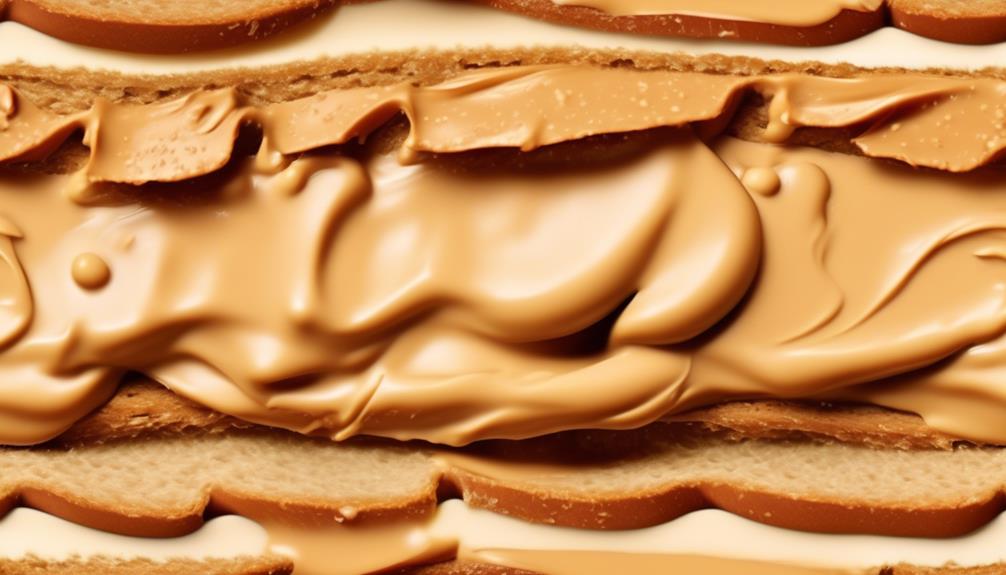We have all heard the saying “it sticks to the roof of your mouth like peanut butter,” but what does peanut butter really taste like?
Many of us have grown up with this staple spread, but have we ever truly dissected its flavor profile?
In this discussion, we'll uncover the nuanced taste of peanut butter, exploring its nutty undertones, creamy texture, and the subtle interplay of sweetness and savory notes.
Join us as we unravel the mystery behind the beloved peanut butter and gain a deeper appreciation for its versatile culinary uses.
Key Takeaways
- Peanut butter has a nutty and creamy flavor with sweet and salty notes.
- It has a smooth and rich texture with distinct aroma characteristics.
- Peanut butter is versatile and can be used in various culinary applications, offering different tastes.
- There are different taste profiles for peanut butter, including creamy and crunchy options, with undertones of sweetness, saltiness, and nuttiness.
Nutty and Creamy Flavor
The nutty and creamy flavor of peanut butter perfectly combines roasted nuttiness with a smooth and spreadable texture, offering a delightful balance of natural sweetness and savory notes. When you take a spoonful, the first thing you notice is the rich, nutty taste that fills your mouth. It's not just any nuttiness; it's a deep, roasted flavor that brings warmth to your palate.
As you savor it, the slightly sweet and savory notes unfold, creating a complex taste profile. The creamy texture adds to the experience, coating your tongue with a satisfying smoothness that enhances the nuttiness. It's this combination of flavors and textures that makes peanut butter so versatile.
Whether you're spreading it on toast, blending it into a smoothie, or using it as a dip, the creamy, nutty taste holds its own, adding depth to every dish it graces.
Sweet and Salty Notes

Sweet and salty notes add depth and complexity to the overall flavor profile of peanut butter.
The contrast of sugary and savory elements provides a satisfying balance that appeals to a wide range of taste preferences.
Understanding how these notes interact with the nutty and creamy flavors of peanut butter can enhance the appreciation of this beloved spread.
Flavor Profile Overview
With its rich and comforting taste, peanut butter's flavor profile combines nutty sweetness and a touch of saltiness, creating a harmonious blend that lends versatility to a wide range of culinary creations. When enjoying peanut butter, we savor the delightful interplay of flavors that make it a truly unique and appealing choice.
Here's a closer look at the flavor profile overview:
- Nutty Sweetness: The sweetness in peanut butter, often derived from added sugars, contributes to its luscious and indulgent taste, making it an irresistible treat for many.
- Salty Undertones: The subtle saltiness in peanut butter enhances its overall flavor, providing a balanced and satisfying contrast to the sweetness, elevating the taste experience.
- Versatile Ingredient: This unique flavor profile makes peanut butter suitable for both sweet and savory dishes, catering to a wide range of taste preferences.
- Well-Rounded Flavor: The harmonious blend of sweet and salty notes in peanut butter ensures a delightful and well-rounded flavor experience, making it a beloved pantry staple for many.
Taste Comparison With Jelly
Transitioning from the discussion of peanut butter's flavor profile overview, we can now examine its taste comparison with jelly, particularly focusing on the interplay of sweet and salty notes.
Peanut butter offers a rich, roasted peanut flavor with a creamy texture, complemented by a subtle sweetness. When paired with jelly, the contrast between the savory, nutty notes of peanut butter and the fruity sweetness of jelly creates a classic sweet and salty flavor combination.
The peanut butter's nutty and slightly sweet taste harmonizes with the sweet, fruity notes of the jelly, resulting in a balanced flavor profile. This combination provides a satisfying contrast of flavors, making it a popular choice for sandwiches, snacks, and desserts.
The interplay of sweet and salty notes in the peanut butter and jelly pairing offers a delightful sensory experience.
Texture and Aroma Characteristics
Upon analysis of the texture and aroma characteristics of peanut butter, it becomes evident that the interplay of sweet and salty notes significantly influences its overall flavor profile.
- The sweet notes in peanut butter contribute to a caramel-like aroma and a creamy, smooth texture, adding a delightful richness to the spread.
- On the other hand, the salty notes enhance the overall flavor profile, providing a savory undertone and a slightly gritty texture, creating a perfect balance with the sweetness.
- This combination of sweet and salty notes creates a complex flavor profile, making peanut butter a versatile ingredient in both sweet and savory dishes.
- The interplay of these characteristics greatly influences the overall taste experience of peanut butter, making it an indulgent and satisfying treat for many.
Smooth and Rich Texture

Smooth peanut butter's velvety consistency provides a luxurious mouthfeel, making it a delightful addition to a variety of recipes. When you scoop or spread smooth peanut butter, its creamy and fine texture is immediately noticeable, creating a sense of indulgence with each bite. The richness of its texture allows for effortless spreading on bread or crackers, enhancing the overall experience of consuming this delectable spread.
Whether used in baking, cooking, or enjoyed on its own, the luscious texture of smooth peanut butter adds a satisfying creaminess to both sweet and savory dishes. Its decadent feel elevates the overall enjoyment, making it a go-to choice for those seeking a comforting and delightful treat.
The fine, consistent texture of smooth peanut butter contributes to its versatility, seamlessly blending into various recipes to provide a delightful and indulgent experience. Whether as a standalone spread or an ingredient in a dish, the smooth and rich texture of peanut butter is undeniably an essential component of its appeal.
Versatile Culinary Uses

With its luscious texture enhancing various recipes, peanut butter demonstrates its versatility in culinary applications. The rich and nutty flavor of peanut butter enhances both sweet and savory dishes, making it a staple in many kitchens.
- Savory Delights: Peanut butter shines in savory dishes like Thai peanut sauce for noodles, adding a creamy and nutty depth to the dish. It can also be used as a marinade for grilled chicken or tofu, imparting a delightful flavor profile.
- Sweet Indulgences: In classic sweet treats, peanut butter takes center stage in cookies, brownies, and fudges, offering a rich and unmistakable taste.
- Breakfast Bonanza: Adding peanut butter to breakfast dishes like smoothies, oatmeal, and pancakes elevates the flavor profile and provides a protein boost, making mornings more delicious and nutritious.
- Dip and Dressing Dynamo: The creamy and rich nature of peanut butter makes it a perfect base for dips, whether it's savory peanut butter hummus or a sweet peanut butter fruit dip. Additionally, it serves as a flavorful addition to dressings and vinaigrettes, enhancing salads and appetizers.
Peanut butter's versatility in culinary uses extends beyond these examples, making it a beloved ingredient for both home cooks and professional chefs.
Taste in Different Applications

In various culinary applications, the taste of peanut butter exhibits a harmonious blend of nuttiness, subtle sweetness, and savory richness, complemented by a range of textures from smooth to crunchy. When used in sweet applications such as desserts, the nutty flavor of peanut butter adds depth and complexity, enhancing the overall taste with its creamy texture.
In savory dishes, peanut butter contributes a unique richness that complements spicy and umami flavors, creating a well-balanced taste profile. The versatility of peanut butter extends to its texture, offering options for those who prefer a smooth, creamy consistency as well as those who enjoy the added crunch of peanut pieces in chunky varieties.
Whether used in classic recipes like PB&J sandwiches and cookies, or in more innovative ways like salad dressings and marinades, the taste of peanut butter enhances the overall flavor profile of the dish. Its ability to serve as a substitute for oil or butter in baking recipes further demonstrates its adaptability in different culinary applications.
When choosing peanut butter for various uses, it's important to consider personal preferences such as natural or processed varieties, texture, sweetness, and any dietary restrictions or allergies.
Variations in Taste Profiles

When it comes to peanut butter taste profiles, we're often confronted with choices between creamy and crunchy textures, as well as varying levels of sweetness and saltiness.
Additionally, the nutty undertones in different peanut butter variations also contribute to the overall taste experience. These factors play a significant role in shaping our preferences for peanut butter and understanding the diverse range of taste profiles available in the market.
Creamy Vs. Crunchy
Comparing the taste profiles of creamy and crunchy peanut butter reveals distinct characteristics that cater to different preferences and culinary applications.
- Creamy Peanut Butter: It offers a smooth, velvety texture and a uniform, spreadable consistency. The taste is rich and pure, with a creamy mouthfeel that makes it ideal for spreading and baking.
- Crunchy Peanut Butter: It provides a satisfying crunch from small peanut pieces mixed into the smooth base, adding a textural contrast. The taste is robust, with added texture, offering a more substantial and rustic experience.
- Versatility: Creamy peanut butter is preferred for spreading, while crunchy peanut butter adds a satisfying crunch to dishes.
- Preference: Whether one enjoys the pure, smooth taste of creamy peanut butter or the added texture and crunch of crunchy peanut butter, the choice ultimately depends on individual preferences and the specific culinary application.
Sweetness and Saltiness
Moving from the discussion of the textural differences between creamy and crunchy peanut butter, we can now explore the variations in taste profiles, specifically focusing on sweetness and saltiness.
The sweetness and saltiness of peanut butter are key factors that contribute to its overall flavor. Some peanut butter brands incorporate added sugars, resulting in a sweeter taste, while others may have a saltier profile due to varying salt content. Furthermore, the natural sweetness of peanuts and the amount of salt added during processing also influence the taste profile.
These variations provide consumers with a diverse range of options to suit their flavor preferences. By understanding the interplay of sweetness and saltiness in peanut butter, individuals can make informed choices to select a product that aligns with their taste preferences.
Nutty Undertones
Exploring the intricate world of peanut butter taste profiles reveals a spectrum of nutty undertones ranging from deeply roasted and earthy to mildly sweet and toasty, offering consumers a diverse array of flavor experiences.
- Roasted Intensity: Some peanut butters exhibit a deeply roasted flavor, providing a robust and intense nuttiness that appeals to those who enjoy a more pronounced taste.
- Sweetness Levels: The sweetness of peanut butter can vary significantly, with some brands offering a mildly sweet profile while others tend towards a more sugary taste, catering to different preferences.
- Earthy Richness: Certain peanut butters carry earthy undertones, imparting a rich and natural nuttiness that appeals to individuals seeking a more wholesome flavor experience.
- Toasty Aromas: The aroma of peanut butter varies, with some brands boasting a toasty and warm fragrance that enhances the overall tasting experience, appealing to those who appreciate sensory indulgence.
Factors Affecting Taste

Understanding the factors that influence the taste of peanut butter is essential for appreciating the complexity of its flavor profile. The taste of peanut butter can vary based on several factors, including the amount of sugar added, the types of peanuts used, and the presence of healthy fats.
The amount of sugar in peanut butter can significantly affect its taste, with some brands offering options that range from unsweetened to extra sweet. Different types of peanut butter, such as creamy or chunky, also contribute to the overall taste experience. In a Blind Taste Test, popular brands often showcase their distinct flavor profiles, allowing consumers to identify the best tasting peanut butter for their preferences.
Additionally, the incorporation of healthy fats, like those found in almond butter, can influence the richness and depth of the taste. When considering the factors affecting the taste of peanut butter, it becomes evident that the interplay of ingredients and processing methods results in a wide range of flavor experiences, making it a versatile and beloved spread.
Pairing With Other Ingredients

When it comes to pairing peanut butter with other ingredients, we encounter a world of flavor combinations, texture contrasts, and sweet and savory experiences.
By combining peanut butter with fruits like bananas, apples, and strawberries, a creamy and nutty element is added to the sweetness of the fruits.
The classic and indulgent flavor combination of peanut butter and chocolate is perfect for desserts and sweet treats, offering a delightful contrast in both flavor and texture.
Additionally, the addition of spices like cinnamon, nutmeg, or cayenne pepper can enhance the depth and warmth of peanut butter's flavor profile.
Flavor Combinations
Pairing peanut butter with complementary flavors enhances its nutty, savory, salty, and sweet profile, creating a versatile ingredient for a wide range of culinary creations. When considering flavor combinations, personal preference plays a significant role in determining the best tasting peanut butter for pairing with other ingredients.
Here are some delightful flavor combinations to elevate your culinary experience:
- Sweet and Salty: Combine peanut butter with honey or chocolate for a delectable sweet treat with a hint of saltiness.
- Spicy Kick: Infuse peanut butter into spicy sauces or dressings to add a creamy, nutty element while balancing the heat.
- Umami Richness: Blend peanut butter into savory marinades or glazes for an umami-packed flavor boost.
- Fruity Pairing: Pair peanut butter with fruits like bananas or apples for a delightful balance of creamy, nutty, and fresh sweetness.
Texture Contrasts
Exploring the textural contrasts in peanut butter pairings with other ingredients reveals the potential to elevate culinary experiences through diverse mouthfeel sensations. When considering texture contrasts, pairing peanut butter with complementary elements can create a symphony of sensations in every bite. The table below highlights some exemplary pairings that demonstrate the delightful textural interplay when combining peanut butter with various ingredients.
| Peanut Butter Pairing | Texture Contrast | Example |
|---|---|---|
| Granola | Crunchy | Peanut butter granola bars |
| Bananas | Creamy | Peanut butter banana smoothie |
| Warm toast | Contrasting Temperatures | Peanut butter toast |
Sweet and Savory
Incorporating peanut butter into both sweet and savory dishes offers a versatile flavor profile that can elevate a wide range of culinary creations. When considering its sweet and savory applications, peanut butter offers a delightful balance of flavors that can enhance various dishes.
Here are four ways to pair peanut butter with other ingredients:
- Sweet: Peanut butter complements sweet flavors like chocolate, banana, honey, and jelly, adding depth and richness to desserts and snacks.
- Savory: It pairs well with spicy and umami-rich ingredients such as soy sauce, ginger, garlic, and chili, making it suitable for savory dishes like satay, stir-fries, and sauces.
- Texture: The choice between smooth and crunchy peanut butter can impact the overall texture and mouthfeel of the dish.
- Customization: Preferences for natural versus processed peanut butter, sweetness levels, and texture play a significant role in creating the perfect sweet or savory dish.
Unique Taste Characteristics

Peanut butter exhibits a rich, nutty flavor with a slight sweetness and saltiness, complemented by a creamy texture and a subtle natural grittiness from the ground peanuts. Additionally, there's a distinct roasted and earthy undertone to its flavor profile, adding depth and complexity. This unique combination of flavors makes peanut butter suitable for a wide range of culinary applications, from sweet to savory dishes. The interplay between its sweetness and a subtle savory quality provides a balanced taste that's versatile and appealing.
Furthermore, some variations of peanut butter may surprise the palate with a unique floral or fruity aftertaste, further enhancing its complexity. This unexpected twist adds an intriguing layer to the overall taste experience, making it an exciting ingredient to work with in cooking and baking. The intermingling of these diverse taste characteristics creates a memorable and satisfying gustatory experience, making peanut butter a beloved staple in many households.
Popular Peanut Butter Combinations

With the unique taste characteristics of peanut butter in mind, it's intriguing to explore the popular combinations that enhance its versatile flavor profile.
- Peanut Butter & Jelly: This classic combination strikes a perfect balance between the sweetness of jelly and the nuttiness of peanut butter. The smooth and creamy texture of peanut butter melds seamlessly with the fruity tang of jelly, creating a timeless flavor duo.
- Peanut Butter & Banana: The creamy consistency of peanut butter pairs harmoniously with the natural sweetness and texture of bananas. This combination offers a delectable blend of flavors and a satisfying contrast in mouthfeel.
- Peanut Butter & Honey: A delightful marriage of sweet and savory, this pairing elevates the nutty essence of peanut butter. The addition of honey enhances the overall flavor profile, creating a tantalizing taste experience.
- Peanut Butter & Chocolate: The rich, creamy taste of peanut butter complements the sweetness of chocolate, resulting in a decadent treat that tantalizes the taste buds with its luscious combination of flavors.
These popular combinations showcase the versatility of peanut butter, offering a range of delightful flavor experiences that cater to different preferences.
Frequently Asked Questions
How Does a Peanut Butter Taste?
Peanut butter tastes nutty, slightly savory, and a little sweet and salty. It comes in two textures: crunchy with peanut bits and smooth and creamy.
It's versatile, used in both sweet and savory dishes, pairing well with spicy and umami-rich flavors. Personal preference influences the best tasting peanut butter, varying based on texture, natural versus processed, and sweetness.
If you don't like peanut butter, you can try other nut or seed butters like almond or sunflower seed butter.
Is Peanut Butter Salty or Sweet?
Peanut butter strikes a perfect balance between salty and sweet flavors. Its delightful combination of savory and sugary notes makes it a versatile addition to various dishes. The saltiness and sweetness complement each other, creating a harmonious taste experience.
This unique flavor profile contributes to the widespread appeal of peanut butter, allowing it to be enjoyed in both sweet and savory culinary creations.
How Do You Describe Peanut Butter?
Peanut butter has a rich, nutty flavor with a hint of sweetness and saltiness, making it versatile for both sweet and savory dishes.
It has a smooth, creamy texture and can be spread easily. Some varieties may have a slight graininess due to finely ground peanuts.
How Would You Describe the Flavor of Peanut?
The flavor of peanut butter is rich and nutty with a hint of sweetness and saltiness. It has a creamy, slightly roasted taste, and a smooth, thick texture that makes it spreadable and enjoyable.
The versatility of its flavor allows it to pair well with both sweet and savory ingredients. The taste may vary slightly depending on the brand and whether it's natural or processed.
Conclusion
Overall, peanut butter offers a unique combination of nutty, sweet, and savory flavors, along with a smooth and creamy texture. Its versatility in culinary uses makes it a popular choice for many people.
Whether spread on a sandwich, mixed into a dessert, or enjoyed on its own, peanut butter has a taste that can satisfy a variety of cravings. It's truly the 'icing on the cake' when it comes to adding depth and richness to different recipes.









